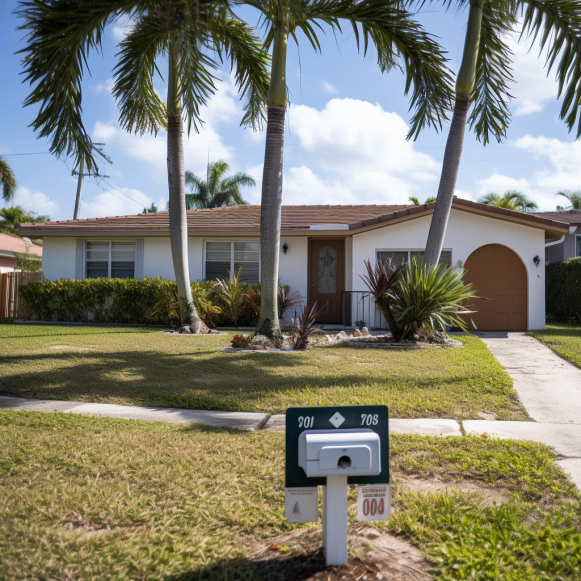What happened to mortgage rates this week? There’s room ‘to fall further’

According to Bankrate’s weekly national survey of large lenders, the average 30-year fixed mortgage rate fell to 7.41% this week, down from 7.55% the previous week.
According to housing economists, the recent reprieve could signal a prolonged drop in mortgage rates. The average 30-year mortgage rate topped 8% in October, but that’s changing due to a number of factors, including a slowing job market and signs that the Federal Reserve’s ongoing war on inflation is working.
“Part of it is because the Federal Reserve is pausing on interest rate hikes,” says Lisa Sturtevant, chief economist at Bright MLS, a Mid-Atlantic real estate listing service. “Of course, other factors influence mortgage rates besides what the Fed does.” Mortgage applications, for example, are down, and lenders are competing for a smaller pool of applicants.”
Meanwhile, 10-year Treasury bond yields, which serve as an informal benchmark for 30-year mortgage rates, have fallen from 5% to less than 4.3% in recent weeks.
Although the Fed does not directly control mortgage rates, it does play an important role. The central bank makes policy decisions that influence the cost of home loans. The Federal Open Markets Committee decided to leave interest rates unchanged at the conclusion of its most recent meeting on November 1. Economists believe the Fed has reached the end of its rate-hiking cycle.
What happened to mortgage rates this week
In this week’s survey, 30-year fixed mortgages had an average total of 0.33 discount and origination points.
The benchmark 30-year fixed-rate mortgage averaged 6.96% over the previous 52 weeks. The 30-year fixed-rate mortgage was 6.78% a year ago. That rate was 7.95% four weeks ago. This week’s 30-year fixed-rate average is 1.14 percentage point higher than the 52-week low of 6.27%.
In terms of other loans:
—The 15-year fixed-rate mortgage fell to 6.78% from 6.85% a week ago.
—The 5/6 adjustable-rate mortgage (ARM) rate was 7.34%, down from 7.42% the previous week.
—The 30-year fixed-rate jumbo mortgage was 7.4% this week, down from 7.52% the previous week.
How mortgage rates affect home affordability
According to the U.S. Department of Housing and Urban Development, the national median family income for 2023 is $96,300, and the median price of an existing home sold in October 2023 was $391,800, according to the National Association of Realtors. Based on a 20% down payment and a 7.41% mortgage rate, the monthly payment of $2,172 is 27% of the average family’s monthly income.
Mortgage rates have risen sharply in the last two years, squeezing affordability and causing a slowdown in home sales. This market is especially difficult for first-time buyers.Home prices have not fallen significantly, and values are unlikely to fall given the scarcity of available homes.
“Higher mortgage rates have a dual impact on the housing market: they reduce affordability for buyers while strengthening rate lock-in for sellers,” says Odeta Kushi, First American’s deputy chief economist. “The combination of reduced affordability and increased strength of the rate lock-in effect is likely to continue to suppress home sales because you can’t buy what’s not for sale, even if you can afford it.”
According to the National Association of Realtors’ 2023 Profile of Home Buyers and Sellers, the median household income for homebuyers will rise to $107,000 in 2023 from $88,000 last year, reflecting the affordability squeeze.
Will mortgage rates fall?
Mortgage rates were expected to fall by the end of 2023, according to economists, but the strength of the US economy has thrown a kink in those predictions. However, things appear to be cooling, particularly 10-year Treasury yields.
The National Association of Realtors’ chief economist, Lawrence Yun, predicts that mortgage rates will fall below 7% during the winter months. “I believe consumer price inflation will be much lower, and that will allow the Federal Reserve to cut interest rates,” Yun said.
Mortgage rates are also linked to inflation, which the Fed is attempting to control. The central bank kept interest rates unchanged at its September and November meetings. While the Fed does not directly set fixed mortgage rates, it does set the tone of the interest-rate environment — and as the Fed’s policy rate has risen from zero in early 2022 to a range of 5.25% to 5.5% now, mortgage rates have followed suit.
“There is still room for mortgage rates to fall further,” says Sturtevant. “Historically, the spread between the 10-year Treasury yield and the 30-year fixed-rate mortgage rate has been around 180 basis points.” While the spread has shrunk slightly, the 30-year mortgage rate is still 280 basis points higher than the bond yield.”
Methodology
Weekly, Bankrate.com conducts a national survey of large lenders. Bankrate collects rate information from the ten largest banks and thrifts in ten major U.S. markets to conduct the National Average survey. Our Market Analysis team collects rates and/or yields on banking deposits, loans, and mortgages for the Bankrate.com national survey. We’ve been conducting this survey in the same way for more than 30 years, and because it’s always been done the same way, it provides an accurate national apples-to-apples comparison. Our rates differ from those of other national surveys, particularly the weekly published rates of Freddie Mac. Every week, Freddie Mac surveys lenders to determine the rates and points for first-lien prime conventional conforming home purchase mortgages with an 80% loan-to-value. “Lenders surveyed each week are a mix of lender types — thrifts, credit unions, commercial banks and mortgage lending companies — is roughly proportional to the level of mortgage business that each type commands nationwide,” Freddie Mac said in a press release.




